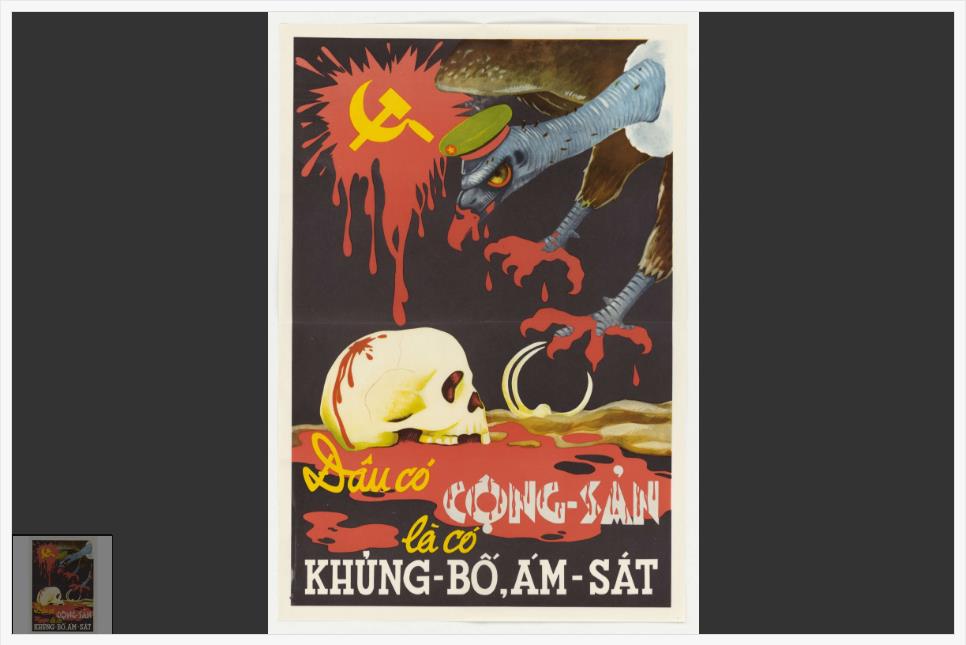In this activity, students will go through the process of analyzing a propaganda poster to better understand propaganda techniques and the perceived threat of communism in the 1950s. They will be introduced to the domino theory and the implementation of the U.S. containment policy in Vietnam.
Suggested Teaching Instructions
This activity can be used during a unit on the Cold War or the Vietnam War. It can serve as an introduction to the domino theory and the U.S. policy of containment during the Cold War, as an introduction to U.S. involvement in Vietnam, or foreshadowing U.S. military involvement in Vietnam. It also serves to teach or reinforce the process of document (poster) analysis. For grades 7-12. Approximate time needed is 30 minutes.
Direct students to begin the activity individually or in pairs. They should spend a few moments looking at the poster unassisted. They won't yet be informed that this poster was distributed by the U.S. Information Agency after the Geneva Accords divided Vietnam in 1954. The text translates to: "Anywhere there is communism, there is terrorism and assassination!"
Students should then proceed to answer the questions that follow, which will guide them through the process of document (poster) analysis:
Meet the document. Observe its parts. Try to make sense of it.Once students have worked through the analysis questions and click "When You're Done," they will be presented with historical background about the U.S. fear of communism during the Red Scare, the domino theory, and the U.S. policy of containment:
This poster says "Anywhere there is communism, there is terrorism and assassination!" It was created and distributed internationally by the U.S. Information Agency (USIA) in 1954, just after the division of Vietnam into North and South.
France had ruled the colony of "French Indochina," including modern Vietnam, Cambodia, and Laos, for decades. After France fell to the Axis powers in World War II, Japan occupied the territory. As WWII came to a close and a Japanese surrender seemed likely, the Viet Minh – a communist-led organization dedicated to Vietnamese independence – launched an uprising and declared Vietnam to be an independent state. However, after WWII, France moved to regain control of the area, leading to war between France and the Democratic Republic of Vietnam (North Vietnam). The Geneva Accords settled the First Indochina War and called for a temporary partition of Vietnam at the 17th Parallel—creating a communist state in North Vietnam and a French-backed non-communist state in South Vietnam.
A "Red Scare" was gripping Americans in the 1940s and 50s. In 1949 the Soviet Union had successfully tested an atomic bomb and Chinese Communists formed the People’s Republic of China. Communist North Korea invaded South Korea the next year. Many interpreted these events as evidence of a global communist plot.
The U.S. government did not want South Vietnam to become communist. Many Americans feared communism as a different political system, and also because of their belief in the "domino theory." First voiced by President Eisenhower, the theory used the visual image of falling dominoes to represent the fear that if South Vietnam "fell" to communism, then Laos, Cambodia, Thailand, Burma (now Myanmar), Indonesia, and Malaysia would also become communist countries. Based on the perceived threat of the domino theory, the U.S. government adopted the policy of containment: trying to contain communism in the countries it was already in and keep it from spreading.
Students will be asked to answer the following in preparation for a class discussion:
- How might people feel about communism after seeing this poster?
- Why do you think the U.S. government would display this poster to the people in South Vietnam? What do you think the U.S. government wanted the South Vietnamese people to do?
- Do you think the containment policy was a good way to deal with communism?
- What else might the United States have to do to enforce containment besides distributing propaganda posters?
As a class, discuss the propaganda techniques used in the poster to persuade the South Vietnamese of the threat of communism: the blood and violent imagery; the color red, hammer and sickle, and star symbolizing communism; and the vulture, skull, and bones symbolizing death.
Next discuss students' answers to each of the final questions. Students might predict that the United States would ultimately get involved with "containing" communism in Vietnam through military force rather than simply persuasion. The class could ultimately discuss whether students believe that the domino theory justified the United States going to war in Vietnam.





